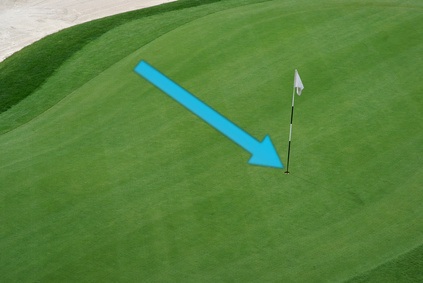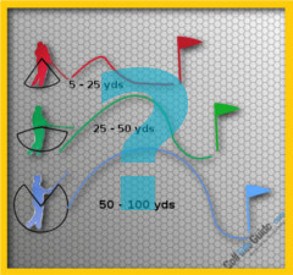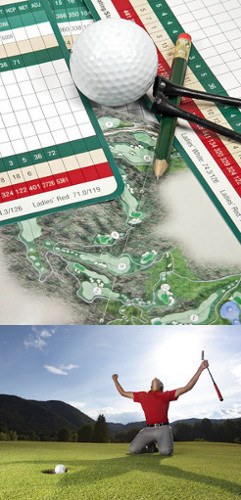
Ask most golfers if distance matters, and you'll get a resounding YES ...and they're right, but not for the reasons they think! What's usually on their mind is “more” distance, but in reality, this only applies to one club in the bag… the Driver.
For all the other clubs in the bag, “more distances" from a golf club is not going to lower your scores. What's crucial for all the other clubs in the bag, is to get a consistent reliable distance from each specific club? For example, you want to know that every time you grab your #7 it's going to go X number of yards. If you have a shot requiring 10 more yards of distance, you grab your #6. (as you play/practice, you'll discover the distance you get out of each club). The important thing here is consistency, and you get that from a club manufactured with the proper distance specifications for that # club; and the club should be built to fit your physique and swing strength.
Some manufacturers will pander to the hype of distance by altering the lengths, lofts and weights of their irons… but all they're doing is turning a #7 into a #6 (and making a mess of things in the process). For reliable performance, use irons with proper specifications that are fitted correctly for you. To become a better golfer with consistent shot making, change your mind-set… when you have a shot requiring more distances, simply grab the next club up in your bag; do not go out and buy a club that says #7 but has been manipulated to try to get the distance of a #6.
The top PGA players have learned the true importance of consistency in golf. Before a rookie comes into the PGA, they (like us) tend to judge their game based on those occasional highlights- reel shots; but later become great players once they learned that those shots have little to do with posting winning scores. Camilo Villegas is just one example, “I've jumped more than 300 spots in the Official World Golf Rankings because my game has become more consistent… I'm repeating my good swing on almost every shot. If you can add this type of consistency to your game, you'll improve faster than you ever thought possible.” Playing golf clubs with proper specs and fit is a major factor to consistent and accurate shot making; the best way to lower your scores!

Does Distance Matter?
Golfers have an obsession with distance. This is plainly seen in the advertising methods golf companies use in an attempt to sell their equipment. It seems that every new driver to hit the market is promoted as the 'longest in the game', and every golf ball promises to add five or ten yards to your shots. Why do club companies use this marketing angle? Because it works. The average golfer loves the thought of adding distance to his or her game.
In this article, we are going to look at the logic behind this obsession with distance. Are golfers justified in their pursuit of greater and greater distances, or should they be focused on other things like controlling trajectories and hitting targets accurately? Right off the bat, we can say that distance certainly does matter to some degree. It is not a coincidence that the best players in the world are also some of the longest hitters in the game. The ability to hit the golf ball great distances does make the game easier. At some point, however, you will experience diminishing returns. Once you have attained a certain level of power, it will probably be best to spend your energy working on making other kinds of improvements.
So, the real question that needs to be answered is how much distance is enough to reach your goals on the golf course. We will take a closer look at this question throughout the content below. It is important that you are honest with yourself regarding your golf goals, as those goals are going to go a long way toward determining how much distance you should try to uncover in your game. For example, if you are a competitive young golfer with dreams of making the PGA Tour, you'll need a lot of distance. There are very few short hitters who manage to make it to the top in the modern game. On the other hand, if you are a recreational player who only wants to take a few strokes off your handicap, distance probably should not be your biggest priority.
Before we get too far into this discussion, we want to make one point perfectly clear – if you are serious about your golf game, there can be no thought of gaining distance just to impress other people. Sadly, this is a focus for many golfers. They want to impress their friends or others at the course with the sheer distance they can create off the tee. If you allow your game to move in this direction, you will certainly lose sight of the goal of playing better golf. Distance can be helpful, of course, but it can't make up for a bad short game or poor course management, just to name a couple of other important skills. Set your vanity to the side and only work on growing your game in a way that will help you perform better with each passing round.
All of the content below is based on a right-handed golfer. If you happen to play left-handed, please take a moment to reverse the directions as necessary.

The Benefits of Distance
As we've already stated, distance certainly does matter in your golf game. If you can add a few yards to your average drive, for example, while maintaining the same level of control, you will be a better golfer. To make sure this point is clear, we wanted to highlight some of the key benefits of distance here in this section. Once you review the points below, you should have an understanding of why long hitters have a distinct advantage in this game.
- Shorter approach shots. There is nothing like shorter approach shots to improve your chances of making a birdie. Would you have a better chance to hit your approach close to the hole from 100 yards, or 150? You already know the answer to that question. As you get closer and closer to the hole, your chances of hitting a great approach increase dramatically (up to a certain point – you can get too close in some situations and find yourself in trouble). Of course, these shorter approach shots are only desirable if you can still place your ball in the fairway. If you begin to stray off into the rough, the benefit will be diminished and you'll have to evaluate whether or not your added distance is actually paying dividends. But make no mistake – as long as you are still controlling your golf ball, hitting longer drives to set up shorter approaches will cause your scores to come down.
- Carry obstacles. This is an often-overlooked advantage of hitting the ball long distances, but it is not one which should be taken for granted. If you have plenty of distance in your bag, you may be able to carry certain obstacles on the course that other players would not be able to carry. For example, imagine a tee shot to a fairway which has a creek running across it from side to side. In order to carry the creek, you need to be able to hit your driver 250 yards in the air. If you have that in the bag, you can fire away. The creek will not be a concern, and you can send your ball way up toward the green in order to setup an easy approach. On the other hand, if you can't hit that shot, you will need to club down to a three wood or hybrid in order to layup. That layup is going to leave you a long approach shot, and you will be far less likely to make a birdie – or even a par – on that hole. Obviously, having the capability to carry the hazard in this case would give you a huge edge over a player who didn't have the necessary power to get the job done.
- Stop the ball quickly. This one is not necessarily a result of sheer distance, but rather the ability to send the ball high up into the air. Players who can generate enough speed to hit the ball long distances are also able to hit the ball high through the use of significant backspin. When you can hit the ball high with a high spin rate, you can stop the ball quickly after it lands – even on longer approach shots. Rather than having to play toward safe targets where you can let the ball bounce and roll, you can aim right at the pin and stop it after just a bounce or two. This is a particular advantage when playing on a firm and fast golf course. It can be tough to access some of the hole locations you will find when playing a firm course, but some of that challenge is taken away when you possess the ability to stop the ball quickly.
The list above could be longer, of course, but those three points are a great place to start. Between setting up shorter approach shots, carrying obstacles on the course, and stopping the ball quickly after it lands, there is a lot to like about being a long hitter. If you are currently a short hitter and you have ever played a match against a more powerful player, you already know how frustrating it can be to come up on the short side of the distance battle. Without the firepower to keep up, you have to be significantly more accurate to win the match. Distance might not be the only thing you need to play good golf, but it is a nice advantage to possess.

The Relationship Between Distance and Goals
If you were to ask the average golfer how far he or she would like to hit the ball, the answer would probably come back the same most of the time - 'as far as possible'! Of course, that is a pretty useless answer. There is a limit to how far you can hit the ball, and there is a tradeoff for adding extra power to your swing. If you are working on gaining distance, you are not working on some of the other parts of your game during that time. And, those omissions can come back to haunt you in the end.
So, in order to maximize the improvements you will experience in your game, one of the first things you need to do is think about your goals on the course. What do you want to accomplish in golf? Even if you have never thought about this topic before, you probably have a decent idea right off the top of your head. Below is a quick list of some of the common goals held by golfers of various skill levels.
-
Make it to the PGA Tour. This is a goal held by a very small group of people. If you are thinking in these terms, you should already be an accomplished amateur player with many local and regional victories under your belt. It should go without saying that you are going to need plenty of distance if you are going to achieve this lofty goal. Players at this level can usually move the ball 300+ yards from the tee, even if they are not all able to do so consistently. For 99% of the readers of this article, this first goal is not going to apply.
- Compete in regional golf competitions. For the serious amateur golfer, a common goal is to be able to play in local and regional golf tournaments at a competitive level. Your local golf association likely hosts competitions throughout the golfing season, and you may have aspirations of playing well in these events. If that is the case, you are going to need a modest amount of distance – but maybe not as much as you would think at first. These kinds of tournaments don't tend to be played on hugely long golf courses, and they aren't always played from the tips. As long as you can hit your driver in excess of 250 yards with regularity, you should focus on other parts of your game rather than trying to gain distance.
- Gradually lower your average score. This is the most common goal in the game, and it is one that is held by millions of players. At this level, you don't really care about competing with others so much as you care about improving your own play. Rather than shooting in the low 100s, you want to shoot in the high 90s. Or, rather than shooting in the low 90s, you want to break into the 80s. Whatever the case, your ongoing goal is to be a bit better tomorrow than you were yesterday. When this is your approach to the game, you can almost completely ignore distance as a consideration. To elevate your game, you should instead think about your short game, the variety of shots you can hit, and your course management skills.
Playing good golf does not have to be tied to hitting the ball a tremendous distance. Sure, players at the top of the game need to have sufficient distance to deal with those long courses, but very few people in the world need to concern themselves with that challenge. More likely, you are an average golfer who would simply enjoy finding a way to carve a few strokes off of your average score. If that sounds like you, set aside any thoughts about adding distance and focus in on the skills that will actually make you a better golfer.






